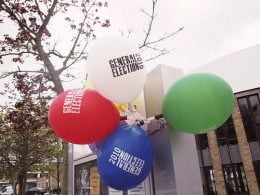

Features
100 days until a pivotal UK general election
The weekend’s vote in Greece will have a significant effect on the EU and the Eurozone. The coming negotiations will bring into focus the EU’s willingness to be flexible – something that will matter if we are to renegotiate the terms of our own membership. Closer to home, in May we face the most unpredictable election outcome since the universal suffrage.
The UK’s first post-war coalition experiment, debates about leader debates, decisions about what constitutes a ‘major’ party, insurgent ‘other’ parties, party defections, the Scottish referendum with further devolution promised; all mean we’re experiencing one of the most politically engaged electorates in decades. But an electorate that seems to be ready to reject the old two (or three) party system.
The Conservatives, unaccustomed to a fractured right wing landscape, are facing an insurgency by UKIP in traditional safe seats on the east coast. Labour is facing a confident Scottish National Party across Scotland and from the Greens and UKIP in England and Wales. Also in Wales, Plaid Cymru should certainly be able to capitalise on the possibility of a hung parliament. The so-called ‘minor’ or ‘other’ parties are really on the march, in an electoral system designed to see power smoothly handed between the two major parties.
Under the first-past-the-post system, which was pretty decisively backed in the AV referendum in 2011 (68% against AV, on a 42% turnout), MPs can be elected without an overall majority (more than 50%) of support from their constituency electorate, including both those who vote and those who don’t.
In an imaginary seat with 70,001 voters (the average is 68,175) where support was balanced equally between seven parties (i.e. 10,000 votes each), an MP could be elected with just one more vote than the others (10,001, or a ‘simple majority’), i.e. just 14% of the vote. With only 65% of the electorate turning out this would mean them taking a seat in the House of Commons with just over 9% of their constituency electorate backing them as a candidate and their party’s policies.
Not so imaginary in 2010. Not one MP in 2010 secured more than half of their total constituency electorate’s support. Not one. The highest was 47% in Westmorland & Lonsdale. In 95 seats, or one in seven, the sitting MP won with less than a quarter of the support of the constituency electorate. In 54 seats, those not voting actually ‘beat’ the winning candidate’s share of the vote. The real winner in many elections has been ‘none of the above’. It’s hard to legitimately claim a mandate if your policies have been roundly rejected by an overwhelming majority of your constituents, but it does allow you to ignore the views of the majority of them if you know you can win a seat with a core vote of less than 25%.
Proportional representation, in its many forms, tries to address this perversity by allowing votes to be moved to second and third preference, and so on, so that every vote counts, and the winner has a genuine majority of support, albeit not always as the voters’ first preference.
A greater range of political parties and more diverse policies has to be a good thing for democracy, but they will make the election result volatile. In 2010 the Electoral Reform Society deemed that 59% of seats were ‘safe’, and 53% of all votes were cast for losing candidates, the growing emergence of ‘minor’ parties will further affect these figures. Due to the above perversities of first-past-the-post, a party that secures a simple majority in each constituency but overall minority support in the electorate can win the greatest share of the seats on a small share of the vote. It’s the story of every election since 1945 – less than half of the votes (33% on average), more than half of the seats (55%).
In the build up to 2015 election, Blue & Green Tomorrow will be working with voteforpolicies.org.uk, the crowdfunded political website. The site presents party policies on all major policy areas without their party label. Using their questionnaire you can find which party most delivers on the policies you would like to see enacted. They aim to reach 5 million people during the election allowing people to make informed choices on the party they should choose.
In 2010, the overwhelming winner in terms of policy areas was the Green Party manifesto.
Not a bad way to decide who to vote for or a general election, for that matter. A great way for an independent to create an electorate-generated and electorate-pleasing manifesto.
Without reform to our now defunct electoral system it’ll come down to voters using their vote on principal, backing the party whose policies they most support, or tactically, backing the party most likely to dislodge a party whose policies they most dislike. Voting for a party of a particular hue, just because it’s what you’ve always done, will be a wasted vote for a defunct democracy.
It’s certainly going to be an interesting 100 days.
And finally – we’re not affiliated with any party. Blue and green is the colour of our planet. Nothing more and nothing less.
Photo: Khairil Zhafri via Flickr
Further reading:
Political parties on the spot: how do we make our democracy sustainable?
If we voted for policies at elections, and not parties, the results might surprise us all
If public vote for policies, not personalities, Boris Johnson and Nigel Farage could lose


 Environment9 months ago
Environment9 months agoAre Polymer Banknotes: an Eco-Friendly Trend or a Groundswell?

 Environment11 months ago
Environment11 months agoEco-Friendly Home Improvements: Top 7 Upgrades for 2025

 Features8 months ago
Features8 months agoEco-Friendly Cryptocurrencies: Sustainable Investment Choices

 Features10 months ago
Features10 months agoEco-Friendly Crypto Traders Must Find the Right Exchange






























